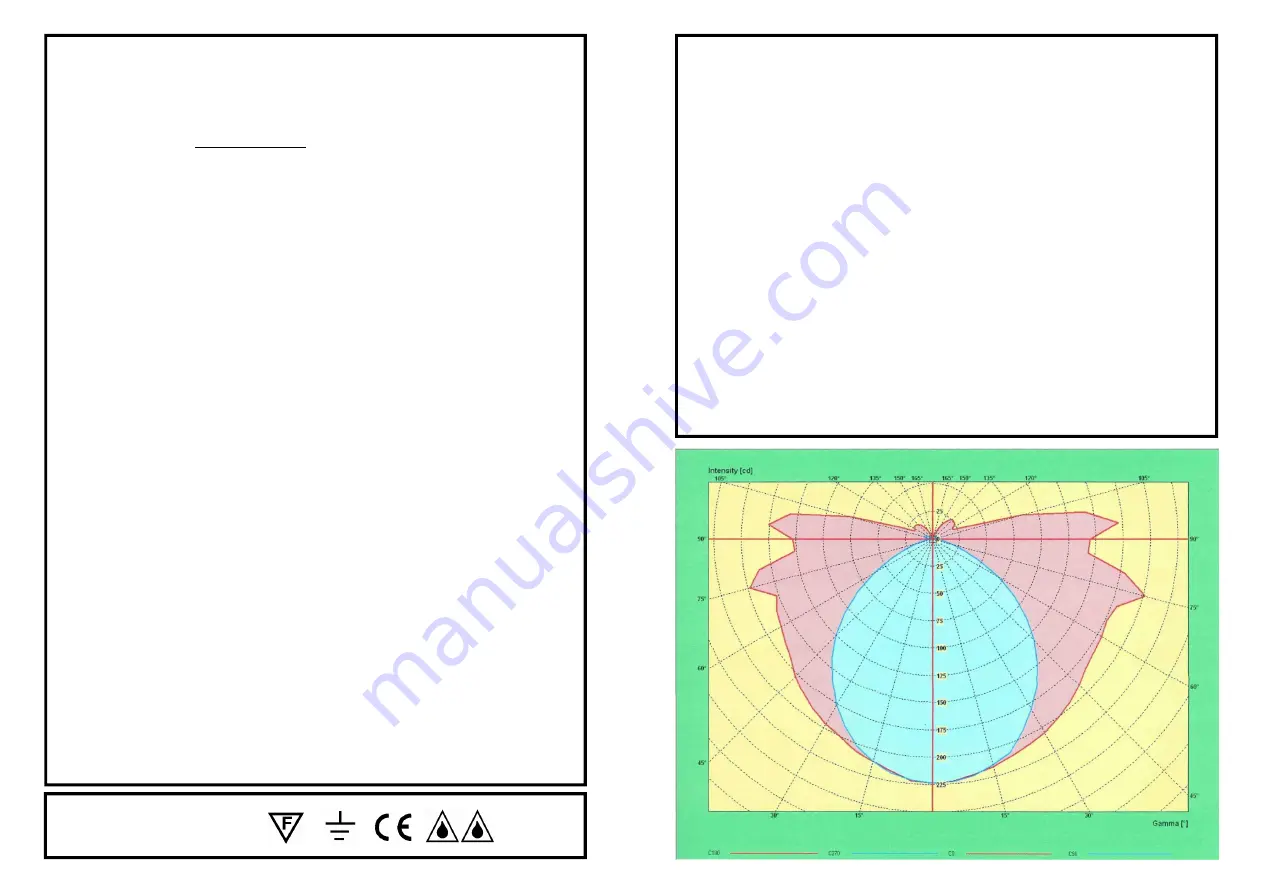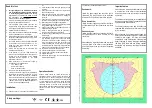
Read this first:
>
This light fitting must be installed in accordance
with the Building Regulations making reference
to the Wiring Regulations BS7671.
The Building
Regulations may be obtained from HMSO or viewed
and downloaded from www.communities.gov.uk
following the link for Building Regulations.
>
Switch off the mains before commencing installation
and remove the appropriate circuit fuse.
>
Your emergency fittings should have their own
separate mains supply circuit and should not share
their supply with other lighting or electrical devices.
>
Suitable for indoor or outdoor use.
>
This product is suitable for installation on flammable
surfaces ( indicated by the "F" in a triangle )
>
Before making fixing hole(s), check that there are no
obstructions hidden beneath the mounting surface
such as pipes or cables.
>
The chosen location of your new fitting should allow
for the product to be securely mounted ( e.g. to a
ceiling joist ) and safely connected to the mains
supply ( lighting circuit ).
>
Ensure that the fitting will be accessible after
installation for maintenance.
>
If the location of your new fitting requires the
provision of a new electrical supply, the supply must
conform with the requirements of the Building
Regulations making reference to the Wiring
Regulations ( see above ).
>
Make connections to the electrical supply in
accordance with the following code:
Live - Brown or Red
Neutral - Blue or Black
Earth - Green and Yellow
>
This product must be connected to Earth.
>
You are advised at every stage of your installation to
double-check any electrical connections you have
made. After you have completed your installation
there are electrical tests that should be carried out:
these tests are specified in the Wiring Regulations
( BS7671 ) referred to in the Building Regulations. If
in doubt, consult a qualified electrician.
Installation:
1) Undo the screws at each end of the diffuser and lift
off.
2) Press the tabs at each end of the gear tray to open
the fitting..
3) Gently prize one of the hinges off of its plastic pin
and lift off the gear tray.
4) Make the cable entry and fixing holes as required.
Inside the back of the fitting, there are markings to
assist you.
5) Using the back of the fitting as a template, mark the
position of the fixing holes on your mounting surface.
6) Make fixing holes and fit plugs as appropriate.
7) Secure the back of the fitting to the mounting surface
using suitable fixings ( not supplied ).
8) Apply a silicon sealant to the fixings if moisture- or
weather-proofing is required.
9) Fitting a cable gland will also be necessary if
moisture- or weather-proofing is required.
10) Thread the supply cable through the entry point and
into the fitting.
11) Press the gear tray back into position on the hinge
pins and allow the gear tray to hang open. Make
connection to the mains supply according to the
colour code opposite. Take care not to leave any
strands protruding from the terminals and to tighten
all terminals securely. Ensure also that the terminals
clamp onto the bare wire and not onto the insulation.
12) Write the current date on the battery pack.
13) Connect the battery pack to the circuit board.
14) Close the gear tray and press back onto the clips.
15) Replace the diffuser.
16) Restore the power supply. The LED should light to
indicate correct charging.
Operation checks:
Periodic testing should be carried out monthly by
simulating a failure of supply, causing the fitting to be
energised from it’s battery. Interruption of the supply
should be carried out by the operation of a local keyswitch
or other isolation device. During this period all fittings
should be examined visually to ensure that they are
functioning correctly. At the end of the test period the
supply shall be restored and all indicator lamps or devices
checked to ensure that the normal supply has been
restored.
Safety markings:
IP65
The duration of the simulated failure shall be:-
Each month:
Isolate the power supply and check the light is
illuminated. This test should last for no more than
45 minutes. Endorse the test record form supplied.
Every six months:
Isolate the power supply and check that the light is
still illuminated after 1 hour. Endorse the test record
form.
Once each year:
Isolate the power supply and check that the light is
still illuminated after 3 hours. Endorse the test
record form.
Please keep this instruction booklet and test record
in a safe place. A fire officer or other authorised
person may want to see your record of inspection
and testing.
Important notes:
Please keep this instruction booklet and test record
in a safe place. A fire officer or other authorised
person may want to see your record of inspection
and testing.
The ballast and control gear must be operated only
within the enclosure supplied. The gear must not be
operated outside of the enclosure.
The battery charging circuit and DC ballast are
separated from the mains by at least basic ( single
layer ) insulation.
When energised by a constant mains supply, the
battery will be constantly charged. On failure of the
constant mains supply, the fitting will switch
automatically using transistorised switching from
battery charging to battery discharge illuminating
the lamp. Both the mains and battery supplies
incorporate fuse protection: see fitting for location
and rating.
Y
D
6
3
0
N
M
N
o
n
-m
ai
n
ta
in
ed
e
m
er
g
en
cy
b
u
lk
h
ea
d
l
ig
h
t
0
7
0
8
0
9
P
A




















